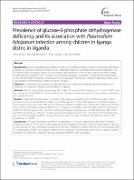| dc.description.abstract | Background: Glucose-6-phosphate dehydrogenase (G6PD) is a metabolic enzyme involved in the pentose phosphate
pathway, its especially important in red blood cell metabolism. Glucose-6-phosphate dehydrogenase deficiency is an
X-linked recessive hereditary disease characterised by abnormally low levels of G6PD. About 400 million people
worldwide have a deficiency of this enzyme. The remarkable geographic correlation of G6PD deficiency distribution
with historical endemicity patterns of malaria has led to suggestions that the two could be linked. Some studies have
concluded that G6PD deficiency confers resistance to malaria.
Objective: To determine the prevalence of G6PD deficiency, and determine its relationship with prevalence and
incidence of P. falciparum infection among children in Uganda.
Methods: This was longitudinal study involving 245 children, 135 were actively followed up for 12 months. G6PD status
was assessed for using PCR-RFLP method. A thick smear was done to determine presence of plasmodium trophozoites
and parasite densities.
Results: A total of 245 children between 6 months and 9 years were recruited. Of these 46.5% were males. Overall
prevalence for the X-linked G6PD A- mutation was; 79.59% wild type, 12.65% heterozygous and 7.76% homozygous or
hemizygous. Among the males 14% were hemizygous. At baseline, 40.8% had asymptomatic P falciparum infection.
There was no statistically significant difference in prevalence and incidence rates of malaria infection among the
different G6PD genotypes with prevalence among heterozygous, homozygous, and wild type being 29%, 42.6%
and 43% respectively (p = 0.11) and incidence among heterozygous and wild type being 0.56 and 0.52 episodes/year
(p = 0.5). The heterozygous G6PD A- females had a lower parasite density compared to the wild type (2505 vs 941
parasites/μL; P = 0.024).
Conclusions: This study showed that 20.41% of the population in this part of Uganda carry the G6PD A-mutation,
within the range of 15-32% seen in other parts of Africa. P. falciparum infection incidence and prevalence rates are
similar among the G6PD genotypes though, once infected, P. falciparum parasite densities are lowest among G6PD
A- heterozygous females. This suggests differences in P. falciparum infection rates and severity of disease could be
mediated by differences in parasite densities among the different G6PD genotypes. | en_US |

